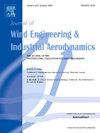On enhancing anti-overturning performance of a high-speed train with side airfoils in crosswinds
IF 4.9
2区 工程技术
Q1 ENGINEERING, CIVIL
Journal of Wind Engineering and Industrial Aerodynamics
Pub Date : 2025-06-16
DOI:10.1016/j.jweia.2025.106151
引用次数: 0
Abstract
The aerodynamic issue in crosswind has become a serious challenge for the operational safety and stability of high-speed trains (HSTs). It's urgent to find out a new strategy to enhance the anti-overturning performance of HSTs. This study proposed a new flow control design with side airfoils (SAs) installed on the leeward side (LWS) of HSTs to improve the vortex structure adjacent the train's leeward side. The results show that the SAs have a beneficial impact on the crosswind aerodynamic loads of the HST with the decrease in the lateral force and overturning moment. The SAs also disturb the airflow over the train top and bottom, and contribute to a large pressure difference, resulting in an extra lift force to resist the overturning moment. Consequently, for the HST, the lift force coefficient is increased by 16.39 %, while the lateral force and overturning moment coefficients are decreased by 5.71 % and 9.41 %, respectively. In addition, the SAs have a considerable influence on the aerodynamic performance of the head car. The lift force coefficient is increased by 39.47 %, while the overturning moment coefficient is reduced by 11.44 %. Therefore, the findings of this study confirm that the SAs can obviously enhance the anti-overturning performance of the HST, which provides a new design method for the next generation higher-speed train travelling in windy regions.
提高侧翼型高速列车侧风抗倾覆性能研究
侧风气动问题已成为高速列车运行安全性和稳定性面临的严峻挑战。寻找一种新的策略来提高高压sts的抗倾覆性能是当务之急。为了改善列车背风侧的涡结构,提出了一种新的流控设计,即在列车背风侧安装侧翼型。结果表明:横向力和倾覆力矩的减小对高速公路侧风气动载荷有显著的影响;SAs还会干扰列车顶部和底部的气流,造成较大的压力差,从而产生额外的升力来抵抗倾覆力矩。结果表明,在高压下,升力系数提高了16.39%,侧向力和倾覆力矩系数分别降低了5.71%和9.41%。此外,sa对头车的气动性能也有相当大的影响。升力系数提高了39.47%,倾覆力矩系数降低了11.44%。因此,本研究结果证实了sa可以明显提高高速列车的抗倾覆性能,为下一代高速列车在多风地区行驶提供了一种新的设计方法。
本文章由计算机程序翻译,如有差异,请以英文原文为准。
求助全文
约1分钟内获得全文
求助全文
来源期刊
CiteScore
8.90
自引率
22.90%
发文量
306
审稿时长
4.4 months
期刊介绍:
The objective of the journal is to provide a means for the publication and interchange of information, on an international basis, on all those aspects of wind engineering that are included in the activities of the International Association for Wind Engineering http://www.iawe.org/. These are: social and economic impact of wind effects; wind characteristics and structure, local wind environments, wind loads and structural response, diffusion, pollutant dispersion and matter transport, wind effects on building heat loss and ventilation, wind effects on transport systems, aerodynamic aspects of wind energy generation, and codification of wind effects.
Papers on these subjects describing full-scale measurements, wind-tunnel simulation studies, computational or theoretical methods are published, as well as papers dealing with the development of techniques and apparatus for wind engineering experiments.

 求助内容:
求助内容: 应助结果提醒方式:
应助结果提醒方式:


